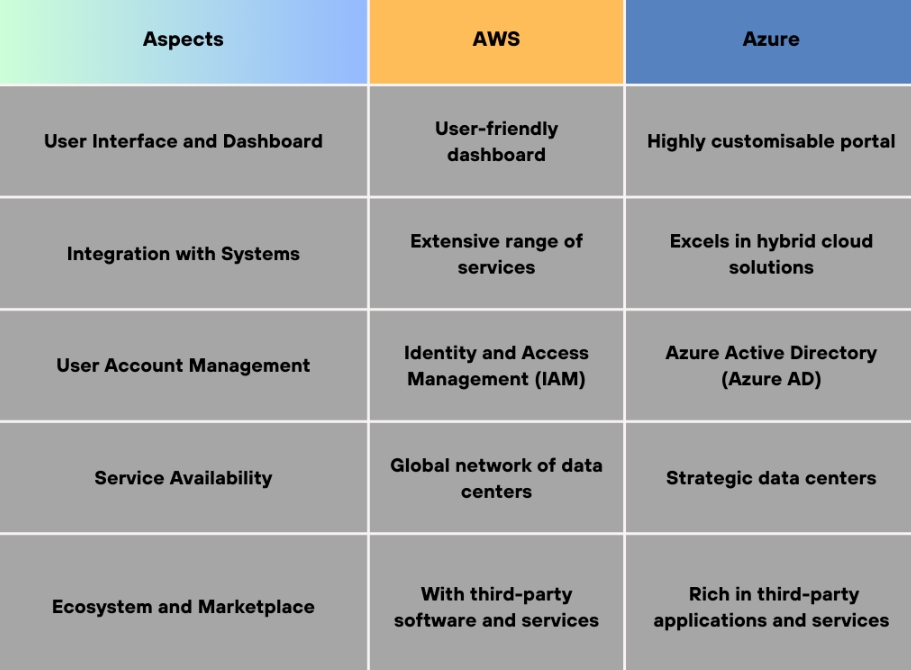Welcome to the ultimate battle between two cloud platforms: Microsoft Azure and Amazon Web Services (AWS). Imagine yourself in a busy tech exhibition where AWS and Azure have set up their most striking exhibits, both fighting for your attention with brilliant displays of the design that highlight the integration features and user experience. Selecting the appropriate cloud platform can feel like negotiating a digital maze, regardless of your level of tech knowledge, business leadership, and expertise with Azure or AWS Courses.
Let’s explore the integration features and user experience of AWS vs Azure in this blog. By the end, you will know which cloud platform fits your requirements. So, buckle up and join us for this comparison of AWS against Azure!
Overview of AWS and Azure Comparison

Let’s analyse each aspect or factors of comparison between AWS and Azure, focusing on user experience and integration capabilities:
User Interface and Dashboard Experience
AWS is easily accessible to novice and professional customers thanks to its user-friendly UI and extensive documentation. Managing AWS services revolves mainly around the AWS Management Console. Its clear and straightforward layout lets consumers quickly negotiate available services. For many computer languages, AWS also provides Command Line Interface (CLI) and Software Development Kits (SDKs), giving developers flexibility to strategically control resources.
On the other hand, Azure appeals to companies already engaged in the Microsoft ecosystem since its interface easily connects with other Microsoft services. The flexible Azure portal lets users customise the dashboard to fit their requirements. This connection covers services like Office 365 and Active Directory, offering a consistent interface for user identity and corporate application management. Like AWS, Azure provides strong CLI and SDK support to guarantee developers have the tools to handle resources effectively.
Integration with Existing Systems
Startups and IT businesses seeking a clean cloud environment generally turn to AWS first. Its broad spectrum of offerings lets companies rapidly create and scale applications. AWS’s connection with on-site systems is not as smooth as Azure’s. Although AWS does provide hybrid solutions, their seamless operation depends on further setup and management.
Azure’s close links to Microsoft’s on-site offerings help it shine in hybrid cloud solutions. For instance, Azure Arc lets customers operate on-site, multi-cloud, edge environments from one control plane. This option is advantageous for companies with current on-site infrastructure wishing to expand their operations to the cloud without a complete overhaul. Azure’s hybrid solutions help manage and scale applications consistently and integrate them across environments.
User Account Management and Security
Through Identity and Access Management (IAM), AWS presents a robust toolkit for user account management and security. IAM lets managers create and oversee AWS users and groups and set rights enabling or prohibiting access to AWS resources. Renowned for its security architecture, AWS offers thorough control over who may access particular resources and what actions they can perform.
Among Azure’s unique qualities is its interaction with Active Directory (AD). Azure Active Directory (Azure AD) is a complete identity and access management cloud solution comprising fundamental directory services, sophisticated identity governance, and application access management. Integrating with Azure AD offers a seamless extension to the cloud for companies currently utilising Microsoft’s AD for on-site identity management, preserving a consistent security architecture across environments.
Service Availability and Reliability
AWS guarantees dependability and high availability with its worldwide network of data centres. Its infrastructure offers robust disaster recovery options since it is meant to manage vast volumes of data and traffic. A strong track record of uptime and dependability characterises AWS’s service availability.
With data centres thoughtfully positioned worldwide, Azure also boasts a major worldwide presence. With similar dependability and performance, Azure’s service availability is competitive with AWS. As Microsoft keeps investing in its cloud infrastructure, Azure services’ general availability and resilience constantly improves.
Ecosystem and Marketplace
The AWS Marketplace gives consumers various choices to improve their cloud environment through outside applications and services. Users may quickly locate and apply the tools they need in the well-ordered market. AWS’s environment is broad and is supported by a sizable developer and partner community.
Azure Marketplace likewise boasts a wealth of apps and services. The Azure Marketplace features several corporate-grade solutions, given Microsoft’s enormous enterprise clientele. Companies already running Microsoft products significantly benefit from this environment since many solutions are meant to fit perfectly with current Microsoft products.
Conclusion
The choice between AWS and Azure is based on your needs, current infrastructure, and long-term cloud plan will determine which one among AWS and Azure you should choose. Both systems are constantly updated to stay competitive and satisfy users’ needs.
Consider The Knowledge Academy to help you choose between these platforms and to advance your skills with the courses it provides.




Post Comment